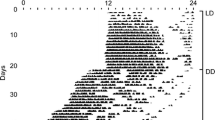Abstract
Synchronization of an internal clock (entrainment) and a direct response to light (masking) are complementary ways of restricting activity of an animal to day or night. The protein CLOCK has an important role in the oscillatory mechanism of mammalian pacemakers. Our data show that it is also involved in masking responses. Mice with the Clock/Clock mutation reduced their wheel running less than wildtypes when given 1-h light pulses of light (2–1,600 lx) in the night. With dimmer lights (<2 lx), there were no significant differences between mutant and wildtype mice. Impaired masking responses to light in Clock/Clock mice were confirmed in tests with ultradian light–dark cycles (3.5:3.5 h and 1:1 h). Tests with pulses of light longer than 1 h revealed that, although the mutants responded more slowly to light, they sustained the suppression of activity over the course of the 3-h tests better than wildtypes.






Similar content being viewed by others
Abbreviations
- SCN:
-
Suprachiasmatic nucleus
- LD:
-
Light–dark
- DD:
-
Constant darkness
- PBS:
-
Phosphate buffer saline
References
Belenky MA, Smeraski CA, Provencio I, Sollars PJ, Pickard GE (2003) Melanopsin retinal ganglion cells receive bipolar and amacrine cell synapses. J Comp Neurol 460:380–393
Dunlap JC (1999) Molecular bases for circadian clocks. Cell 96:271–290
Edelstein K, Mrosovsky N (2001) Behavioral responses to light in mice with dorsal lateral geniculate lesions. Brain Res 918:107–112
Gekakis N, Staknis D, Nguyen HB, Davis FC, Wilsbacher LD, King DP, Takahashi JS, Weitz CJ (1998) Role of the CLOCK protein in the mammalian circadian mechanism. Science 280:1564–1569
Hattar S, Liao HW, Takao M, Berson DM, Yau KW (2002) Melanopsin-containing retinal ganglion cells: architecture, projections, and intrinsic photosensitivity. Science 295:1065–1070
Hattar S, Lucas RJ, Mrosovsky N, Thompson S, Douglas RH, Hankins MW, Lem J, Biel M, Hofmann F, Foster RG, Yau KW (2003) Melanopsin and rod-cone photoreceptive systems account for all major accessory visual functions in mice. Nature 424:75–81
Herzog ED, Takahashi JS, Block GD (1998) Clock controls circadian period in isolated suprachiasmatic nucleus neurons. Nat Neurosci 1:708–713
Kim EY, Bae K, Ng FS, Glossop NR, Hardin PE, Edery I (2002) Drosophila CLOCK protein is under posttranscriptional control and influences light-induced activity. Neuron 34:69–81
King DP, Zhao Y, Sangoram AM, Wilsbacher LD, Tanaka M, Antoch MP, Steeves TD, Vitaterna MH, Kornhauser JM, Lowrey PL, Turek FW, Takahashi JS (1997) Positional cloning of the mouse circadian clock gene. Cell 89:641–653
Lucas RJ, Hattar S, Takao M, Berson DM, Foster RG, Yau KW (2003) Diminished pupillary light reflex at high irradiances in melanopsin-knockout mice. Science 299:245–247
Mrosovsky N (1999) Masking: history, definitions, and measurement. Chronobiol Int 16:415–429
Mrosovsky N (2001) Further characterization of the phenotype of mCry1/mCry2-deficient mice. Chronobiol Int 18:613–625
Mrosovsky N, Hattar S (2003) Impaired masking responses to light in melanopsin-knockout mice. Chronobiol Int 20:989–999
Mrosovsky N, Foster RG, Salmon PA (1999) Thresholds for masking responses to light in three strains of retinally degenerate mice. J Comp Physiol A 184:423–428
Mrosovsky N, Salmon PA, Foster RG, McCall MA (2000) Responses to light after retinal degeneration. Vision Res 40:575–578
Panda S, Hogenesch JB, Kay SA (2002) Circadian rhythms from flies to human. Nature 417:329–335
Panda S, Sato TK, Castrucci AM, Rollag MD, DeGrip WJ, Hogenesch JB, Provencio I, Kay SA (2002) Melanopsin (Opn4) requirement for normal light-induced circadian phase shifting. Science 298:2213–2216
Panda S, Provencio I, Tu DC, Pires SS, Rollag MD, Castrucci AM, Pletcher MT, Sato TK, Wiltshire T, Andahazy M, Kay SA, Van Gelder RN, Hogenesch JB (2003) Melanopsin is required for non-image-forming photic responses in blind mice. Science 301:525–527
Redlin U, Mrosovsky N (1999a) Masking of locomotor activity in hamsters. J Comp Physiol A 184:429–437
Redlin U, Mrosovsky N (1999b) Masking by light in hamsters with SCN lesions. J Comp Physiol A 184:439–448
Redlin U, Vrang N, Mrosovsky N (1999) Enhanced masking response to light in hamsters with IGL lesions. J Comp Physiol A 184:449–456
Redlin U, Cooper HM, Mrosovsky N (2003) Increased masking response to light after ablation of the visual cortex in mice. Brain Res 965:1–8
Selby CP, Thompson C, Schmitz TM, Van Gelder RN, Sancar A (2000) Functional redundancy of cryptochromes and classical photoreceptors for nonvisual ocular photoreception in mice. Proc Natl Acad Sci USA 97:14697–14702
Shearman LP, Weaver DR (1999) Photic induction of Period gene expression is reduced in Clock mutant mice. Neuroreport 10:613–618
Spoelstra K, Oklejewicz M, Daan S (2002) Restoration of self-sustained circadian rhythmicity by the mutant clock allele in mice in constant illumination. J Biol Rhythms 17:520–525
Stanewsky R (2003) Genetic analysis of the circadian system in Drosophila melanogaster and mammals. J Neurobiol 54:111–147
Van Gelder RN (2003) Making (a) sense of non-visual ocular photoreception. Trends Neurosci 26:458–461
Vitaterna MH, King DP, Chang AM, Kornhauser JM, Lowrey PL, McDonald JD, Dove WF, Pinto LH, Turek FW, Takahashi JS (1994) Mutagenesis and mapping of a mouse gene, Clock, essential for circadian behavior. Science 264:719–725
Acknowledgements
We thank Martha Vitaterna for providing us with mice and advice, and Peggy Salmon for taking on the breeding and screening and helping with the analysis. Hsi-Wen Liao, Zinta Zommers, and Leslie Wong also assisted with the experiments. King-Wai Yau kindly made facilities available for immunocytochemistry. These experiments comply with the guidelines of the Canadian Council on Animal Care. Support came from the Canadian Institutes of Health Research.
Author information
Authors and Affiliations
Corresponding author
Rights and permissions
About this article
Cite this article
Redlin, U., Hattar, S. & Mrosovsky, N. The circadian Clock mutant mouse: impaired masking response to light. J Comp Physiol A 191, 51–59 (2005). https://doi.org/10.1007/s00359-004-0570-z
Received:
Revised:
Accepted:
Published:
Issue Date:
DOI: https://doi.org/10.1007/s00359-004-0570-z




